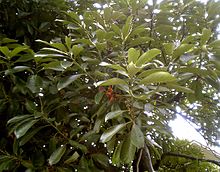
Back ليثوكاربوس ARZ Lithocarpus Breton Lithocarpus Catalan Lithocarpus CEB Litokarpus Czech Garvebarkeg Danish Lithocarpus German Lithocarpus Spanish Lithocarpus French Lithocarpus FRR
| Lithocarpus Temporal range:
| |
|---|---|

| |
| Lithocarpus edulis, Kantō region, Japan | |
| Scientific classification | |
| Kingdom: | Plantae |
| Clade: | Tracheophytes |
| Clade: | Angiosperms |
| Clade: | Eudicots |
| Clade: | Rosids |
| Order: | Fagales |
| Family: | Fagaceae |
| Subfamily: | Quercoideae |
| Genus: | Lithocarpus Blume |
| Species | |
|
See text | |
| Diversity | |
| c. 340 species | |
| Synonyms | |
|
Pasania Oerst. | |


Lithocarpus is a genus in the beech family, Fagaceae. Trees in this genus are commonly known as the stone oaks and differ from Quercus primarily because they produce insect-pollinated flowers on erect spikes and the female flowers have short styles with punctate stigmas. At current, around 340 species have been described,[1] mostly restricted to Southeast Asia. Fossils show that Lithocarpus formerly had a wider distribution, being found in North America and Europe during the Eocene to Miocene epochs.[2] The species extend from the foothills of the Hengduan Mountains, where they form dominant stands of trees, through Indochina and the Malayan Archipelago, crossing Wallace's Line and reaching Papua. In general, these trees are most dominant in the uplands (more than 1,000 m or 3,300 ft above sea level) and have many ecological similarities to the Dipterocarpaceae, the dominant lowland tree group.[3] These trees are intolerant of seasonal droughts, not being found on the Lesser Sunda Islands, despite their ability to cross numerous water barriers to reach Papua.[4][5]
The North American tanoak or tanbark oak (Notholithocarpus densiflorus) was previously included in this genus but recent evidence indicates the similarities in flower and fruit morphology are due to convergent evolution. Both genetic and morphological evidence demonstrate that the tanoak is a distant relative to Asian stone oaks and, therefore tanoak has been moved into a new genus, Notholithocarpus.[6]
Lithocarpus trees are evergreen trees with leathery, alternate leaves, the margins of which are almost always entire, rarely toothed. The seed is a nut similar to an oak acorn with a cupule enclosing the basal part of the fruit. Cupules of stone oaks demonstrate a wide variety in the type and arrangement of lamellae and scales on the outside of the cupule, with some of them completely enclosing the nut, even becoming irregularly dehiscent in a few species. The seeds are often protected by a hard woody shell (hence the genus name, from Greek λίθος, lithos, "stone" and καρπός, karpos, "seed"). In some sections of the genus, the seed is embedded in the basal material of the fruit which becomes highly lignified and hard, lending greater mechanical protection to the seed,[7] creating a novel type of fruit.[8] The kernel is edible in some species (e.g. Lithocarpus edulis), but inedible, and very bitter, in others.
Several of the species are very attractive ornamental trees, used in parks and large gardens in warm temperate and subtropical areas.
- ^ Strijk, J.S. (September 4, 2018). "Lithocarpus - On: asianfagaceae.com – The complete database for information on the evolutionary history, diversity, identification and conservation of over 700 Species of Asian trees". Asian Fagaceae. Retrieved May 4, 2021.
- ^ Liu, Xiaoyan; Song, Hanzhang; Jin, Jianhua (2020-08-14). "Diversity of Fagaceae on Hainan Island of South China During the Middle Eocene: Implications for Phytogeography and Paleoecology". Frontiers in Ecology and Evolution. 8: 255. doi:10.3389/fevo.2020.00255. ISSN 2296-701X.
- ^ Cite error: The named reference
ashton88was invoked but never defined (see the help page). - ^ Cite error: The named reference
cannon03was invoked but never defined (see the help page). - ^ Strijk, Joeri S.; Binh, Hoàng Thi; Ngoc, Nguyen Van; Pereira, Joan T.; Slik, J. W. Ferry; Sukri, Rahayu S.; Suyama, Yoshihisa; Tagane, Shuichiro; Wieringa, Jan J.; Yahara, Tetsukazu; Hinsinger, Damien D. (2020-05-22). "Museomics for reconstructing historical floristic exchanges: Divergence of stone oaks across Wallacea". PLOS ONE. 15 (5): e0232936. Bibcode:2020PLoSO..1532936S. doi:10.1371/journal.pone.0232936. ISSN 1932-6203. PMC 7244142. PMID 32442164.
- ^ Cite error: The named reference
manos01was invoked but never defined (see the help page). - ^ Cite error: The named reference
chen12was invoked but never defined (see the help page). - ^ Cite error: The named reference
cannon00was invoked but never defined (see the help page).
© MMXXIII Rich X Search. We shall prevail. All rights reserved. Rich X Search